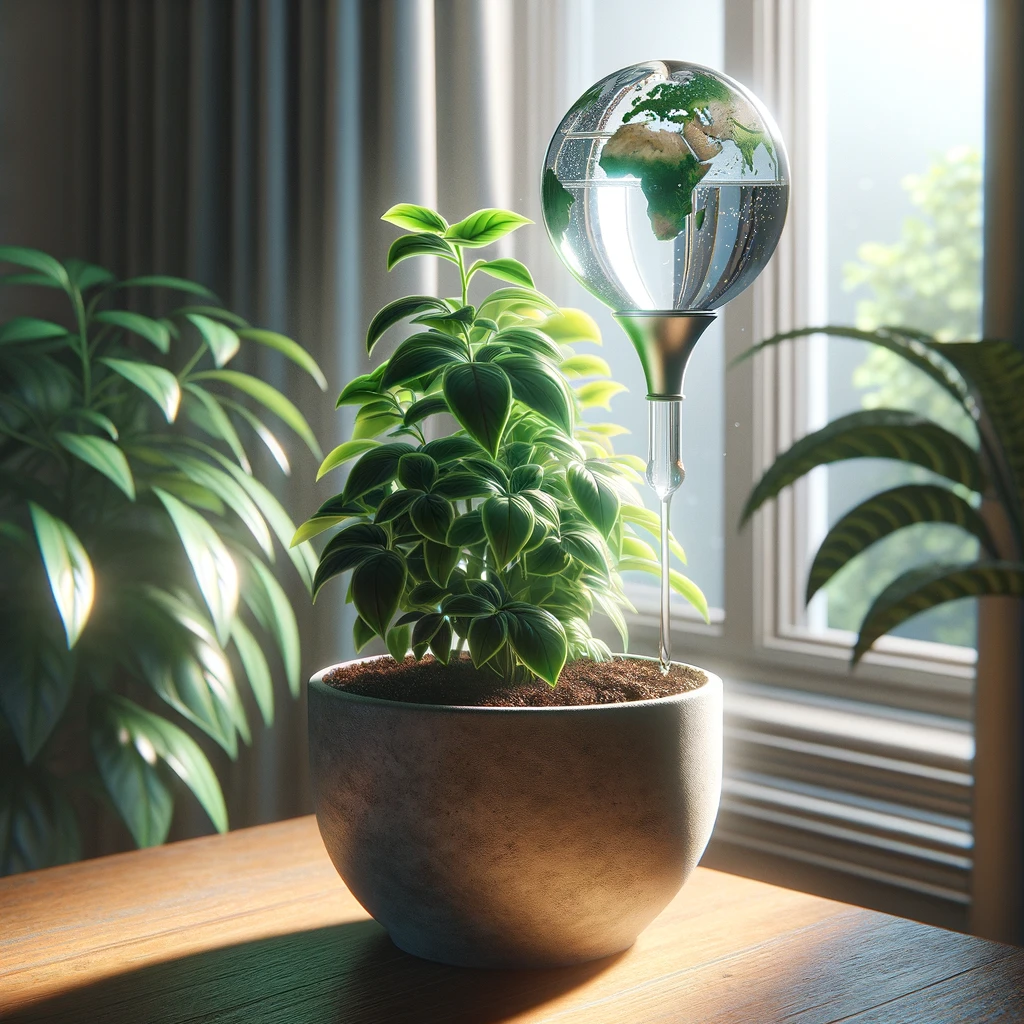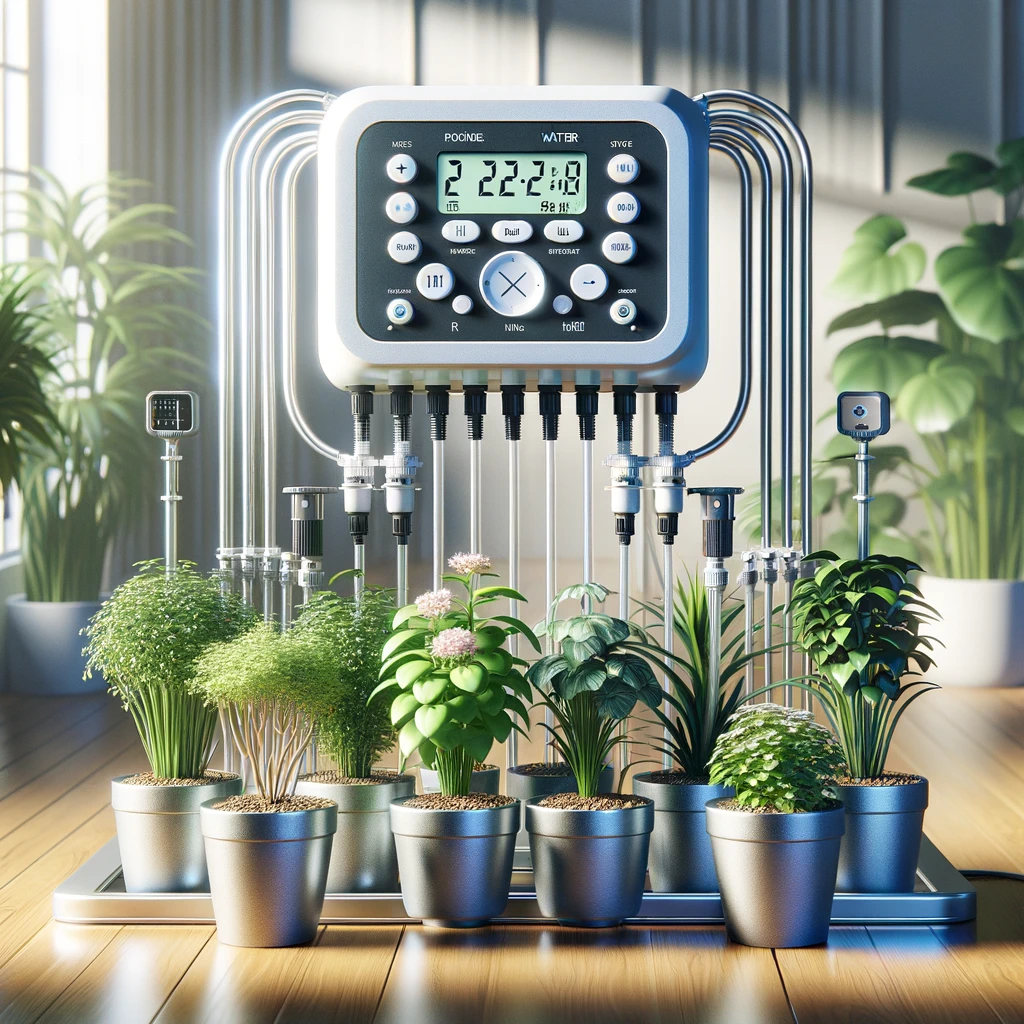
Gardening enthusiasts know that different types of plants have varying watering needs. Succulents thrive on neglect, while tropical plants might crave a daily misting.
Grouping plants with similar water requirements can simplify your care routine significantly.
For instance, keeping moisture-loving ferns and peace lilies together makes it easier to maintain a humid environment beneficial to them, while grouping cacti and aloe together caters to their preference for drier conditions.
This strategic grouping not only enhances the aesthetic appeal of your indoor garden but also sets the stage for efficient watering schedules.
Embracing Technology: The Era of Automated Plant Watering

The concept of automated watering systems is a boon for plant lovers.
These devices, equipped with timers and controls, can administer water to your plants at preset intervals, ensuring they receive the right amount of hydration without the need for daily attention.
This technology is especially handy for those with busy lifestyles or for the care of plants during vacations.
Five of the Best Automatic Watering Solutions

- Self-Watering Planters: These planters have a built-in reservoir that allows plants to absorb water as needed through capillary action. They are ideal for smaller plants and are widely available in gardening stores and online. Examples:
- The Wousiwer 10 inch Self Watering Planters on Amazon are highly rated and feature a deep reservoir that stores extra water. A 40oz capacity can keep plants watered over 7-14 days.
- Gardife 12 inch Plant Pots are designed to act as a reservoir, storing enough water to meet your plant’s needs for a week or longer
- Drip Irrigation Systems: Perfect for a large collection of plants, these systems deliver water directly to the roots through a network of tubes. They can be customized to fit any indoor space and often have programmable timers. Highly rated options on Amazon include:
- The Kollea Reliable Automatic Watering System, Plant Self Watering System Automatic Drip Irrigation Kit has a 60-Day Programmable Timer and is powered by USB. This item costs less than $40, and with over 1,000 5-star ratings on Amazon is an excellent option for a programmable watering system.
- The Geevon WiFi Automatic Indoor Plant Watering System can be controlled using an app on your phone over wifi, making programming easy.
- Wicking Systems: Using a simple setup of a cotton string and a water reservoir, wicking systems are a cost-effective way to keep your soil consistently moist. They’re great for DIY enthusiasts and can be easily set up with materials from any craft or hardware store.
- The Boao 130 Feet Self Watering Wick Cord for plants is easy to use: this water source can help you care your plants while you are away from home or when you go outside or on business.
- Setting up this type of system is simple, but you should make sure it’s the right choice if you’re going to leave your plants alone for an extended time. Do some research before you commit.
- PlanThrive Divas on YouTube show you how it’s done.
- Smart Watering Systems: These high-tech systems connect to your Wi-Fi and allow you to control watering schedules via a smartphone app. Some even adjust watering based on real-time weather data. They are available at tech and gardening specialty stores.
- The Rainpoint WiFi Automatic Watering System For Indoor Potted Plants is controlled over wifi and lets you remotely manage multi-watering plans. Notifications can be sent to the app when Automatic watering plans are active or pump is out of water.
- Globe Watering Stakes: These are glass or plastic globes that release water slowly into the soil. They are both decorative and functional, suitable for small to medium-sized plants, and can be found in most gardening centers.
- Cotswold Homeware Co Plant Watering Globes cost a little over $20, come in a variety of colors, and can keep your plants happy while you’re out of town, or if you just prefer to take a hands-off approach to watering.
- Another option is the Sawowkuya Plant Watering Globes, which are also inexpensive and come in packs of 4. These can be refilled without removing the stake from the soil.
Ranking the Options: Cost and Considerations

- Self-Watering Planters (Low to Medium Cost): While affordable and great for beginners, they can lead to overwatering if not monitored, especially in plants that prefer dry conditions.
- Wicking Systems (Low Cost): The most budget-friendly and customizable option. However, they require regular cleaning to prevent mold growth and may not be suitable for large plants.
- Globe Watering Stakes (Low to Medium Cost): Easy to use and aesthetically pleasing but need refilling and are not ideal for precise watering needs.
- Drip Irrigation Systems (Medium to High Cost): Offer precise watering but are more expensive and require a more complex setup.
- Smart Watering Systems (High Cost): Provide the most control and convenience but come at a higher price point and depend on stable Wi-Fi and power supply.
The Balancing Act: Benefits and Pitfalls of Automated Watering
Automated indoor plant watering systems are fantastic for maintaining a consistent watering schedule, promoting healthy plant growth. They’re particularly beneficial for those who travel frequently or tend to forget regular watering.
However, these systems are not without their challenges. Overwatering can become an issue, especially in systems that do not adjust to the varying needs of different plants. Furthermore, in the event of a power outage or Wi-Fi disruption, smart systems may fail to water your plants as scheduled.
Regular monitoring and occasional manual intervention are still recommended to ensure your plants are receiving optimal care.
Where to Learn More
For those eager to delve deeper into the world of automated watering systems, here are some top resources:
- Gardeners’ World (gardenersworld.com): Offers comprehensive guides on different types of watering systems and plant care tips.
- The Spruce (thespruce.com): A great resource for DIY watering system ideas and gardening advice.
- Plant Care Today (plantcaretoday.com): Provides in-depth articles on various plant care techniques, including automated watering.
- YouTube Gardening Channels: Visual guides on setting up and maintaining different watering systems. One of my favorites is Kill This Plant, a channel with an engaging host who teaches you all about monstera plant care, and indoor gardening generally. Another great channel is Sheffield Made Plants.
While automated indoor plant watering systems offer a convenient way to care for your plants, they are not a ‘set it and forget it’ solution. Regular checks and a good understanding of your plants’ specific needs are crucial. With the right balance, these systems can be a valuable tool in your gardening arsenal, keeping your indoor oasis lush and thriving. 🌿💧🌱
